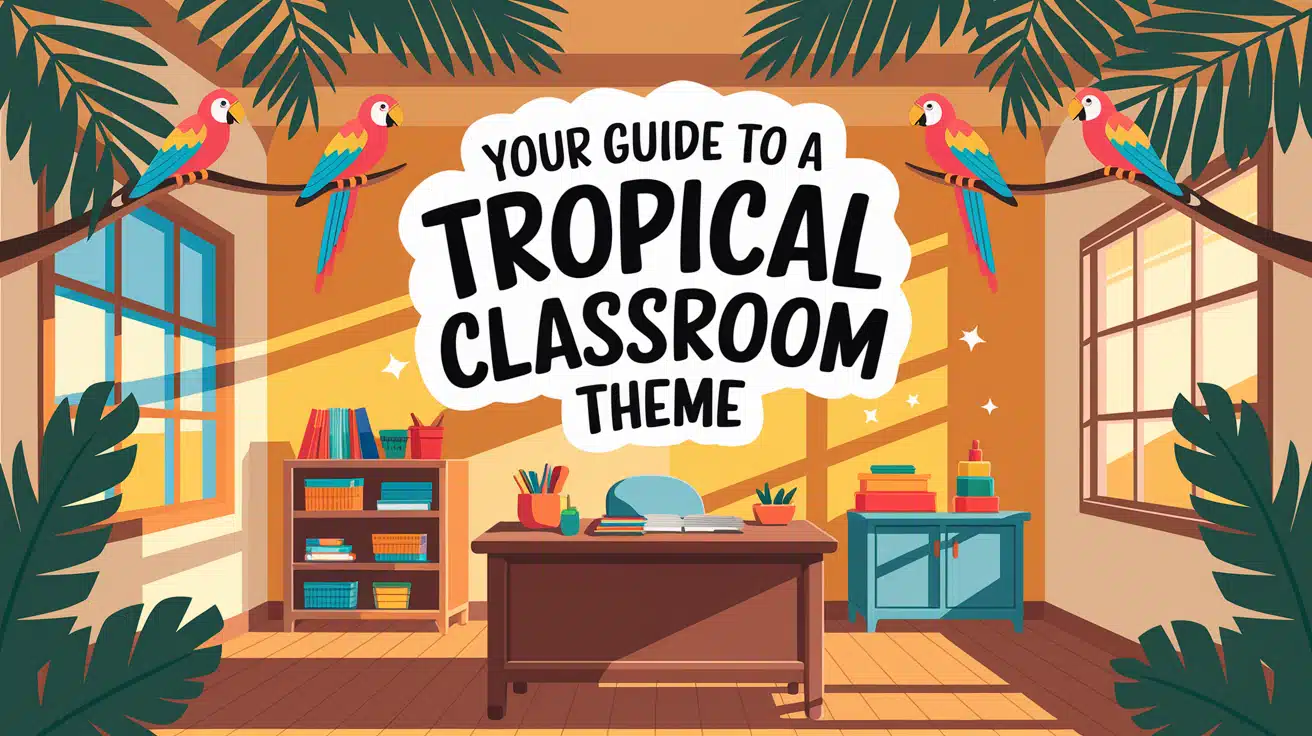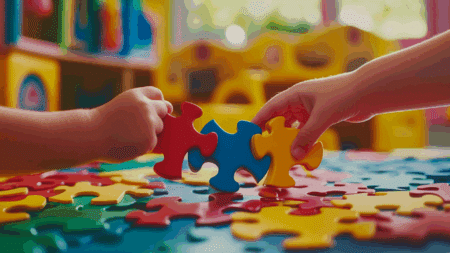Want to make your classroom fun? Try a tropical classroom theme. Kids love walking into a room with bright colors and fun island vibes. It makes learning a great experience.
A tropical classroom theme works for all ages. Young kids enjoy the fun colors, and older students appreciate the calm, natural feel.
Making a tropical classroom theme doesn’t require expensive materials or professional decorating skills. With some creativity and our budget-friendly ideas, you can make a space that students love and that makes learning more enjoyable.
This blog will show you how to pick tropical decorations, make your items, choose the right colors, and change your theme with the seasons. Get ready to create a classroom your students will love!
Why Choose a Tropical Classroom Theme?
Tropical classroom themes bring nature and sunshine indoors. Bright colors like greens, yellows, and oranges create a happy space that wakes up students’ minds. Studies show that natural themes can reduce stress and help students focus better.
The lively palm trees, flowers, and ocean images remind kids of fun, which can make them more open to learning.
Many teachers say students work harder in a room that looks special. This can also help with attendance and behavior.
The great thing about a tropical theme is that it works for any age. Little kids in kindergarten and elementary grades love the fun animals like toucans, monkeys, and colorful fish.
For middle school students, you can make the tropical theme a bit more grown-up by using surfboards for name tags, adding tiki-style decorations, or creating an ocean science corner.
The older kids still like color but want things to look “cool” instead of “cute.”
High school students might think themes are for little kids, but tropical designs can work for them too. Use real plants, detailed nature photos, and more natural colors like deep greens and blues.
Many teenagers actually appreciate a classroom that doesn’t have plain white walls like the rest of the school.
Essential Tropical Decor Items
Transform your classroom into a bright, island-inspired learning space with these must-have tropical decorations:
1. Posters and Wall Art

Posters and wall art are the quickest way to bring tropical vibes to your classroom. Look for large palm tree posters or beach scenes to create a backdrop. Many teacher supply stores sell pre-made tropical posters with motivational sayings paired with palm trees or tropical flowers.
Find colorful images of coral reefs, sea turtles, and tropical fish. These can double as teaching tools when discussing ecosystems or animal habitats.
Flamingos, toucans, monkeys, and parrots bring bright colors and playful energy. During the summer months, many dollar stores carry these at very low prices.
Map posters of tropical regions help connect your theme to geography lessons. Display maps of Hawaii, the Caribbean, or rainforest regions to spark curiosity about different places.
For a personal touch, enlarge and print your own tropical photos. If you’ve visited a beach or tropical location, your authentic pictures will make great conversation-starters with students.
2. Bulletin Boards and Charts

Create a “Welcome to Our Tropical Classroom” board with student names on paper pineapples, coconuts, or surfboards. Add a border of paper palm leaves or pre-made tropical borders available at teacher supply stores.
For tracking progress, design a “Climbing the Palm Tree” chart where student achievements move them up a large palm tree display. Each coconut or leaf can represent reading goals, math facts mastered, or positive behavior points.
Many teachers find success with an “Ocean of Good Work” display where exceptional student work is posted on fish or shell cutouts attached to a blue background with waves.
For downloadable templates, check websites like Teachers Pay Teachers. Many creators offer free tropical-themed bulletin board sets, including borders, lettering, and decorative elements.
3. Editable Classroom Resources

Look for editable tropical name tags, desk plates, and cubby labels. These typically come as PowerPoint or Google Slides files where you can type student names once and print multiple items with the same information.
Tropical-themed lesson plan templates, substitute teacher binders, and parent communication forms help extend your theme to your teaching materials. Many include matching headers, borders, and clip art.
Find editable tropical worksheets, certificates, and awards for assessments and activities. These make everyday paperwork more exciting for students while reinforcing your classroom theme.
The best places to find these resources include Teachers Pay Teachers, Etsy, and teaching blogs. Many creators offer free samples of their editable resources so you can try them before buying complete sets. Most tropical classroom bundles cost between $5 and $15 and can be reused year after year, making them very cost-effective.
How to Create a Tropical Classroom on a Budget
Creating your tropical decorations saves money and adds a personal touch to your classroom! Here are some easy projects you can make with basic supplies:
DIY Tropical Decor Ideas

Paper Palm Trees: Cut long strips of brown butcher paper for trunks. Twist them slightly for texture and tape them to walls or corners. Cut large leaf shapes from green construction paper and attach them to the top of the trunk. For extra detail, add coconuts made from brown paper circles.
Pineapple Paper Chain: Cut yellow paper into 1-inch strips. Form them into loops and connect them to make a chain. For the pineapple top, cut green pointed leaves and attach them to one end. Hang these cheerful chains across your ceiling or around bulletin boards.
Tropical Leaf Garland: Trace different leaf shapes (monstera, palm, banana) onto green paper of different shades. Cut them out and punch holes in the tops. String them together with yarn or fishing line. These look amazing draped across doorways or windows!
Tissue Paper Flowers: Stack 6-8 sheets of colorful tissue paper. Fold like an accordion. Secure the middle with a pipe cleaner or wire. Gently pull apart each layer to form a flower. Make hibiscus, bird of paradise, or simple tropical blooms in bright colors.
Ocean in a Bottle: Have students help create calm-down bottles using clear plastic bottles, blue food coloring, water, and a little baby oil. Add small shells, plastic fish, or glitter. These serve as both decorations and stress-relief tools.
Painted Coconut Cups: Clean and dry coconut halves (or use brown plastic bowls). Paint tropical designs on the outside. Use these as supply holders, treasure boxes, or decoration pieces around the room.
Tropical Reading Corner Tent: Drape green sheets over a corner area to create a “jungle canopy” reading nook. Add paper vines and flowers to complete the effect. Students love reading in special spaces like this!
Affordable Decor Options

You don’t need to spend a lot to create a tropical haven in your classroom. Here are some budget-friendly shopping strategies:
Dollar Store Finds: Look for plastic leis, sunglasses, small beach buckets, and tropical flowers. Dollar stores often have seasonal summer items that work perfectly for classroom decor.
Free Printables: Many teaching websites offer free tropical-themed printables, including desk tags, labels, and posters. Search “free tropical classroom printables” to find hundreds of options you can print yourself.
Digital Decor Bundles: Teacher marketplaces like Teachers Pay Teachers often sell complete tropical classroom theme packages for $5-15. These typically include hundreds of printable items from name tags to banners to lesson materials.
Party Supply Clearance: Shop end-of-summer sales for discounted luau party supplies. Paper umbrellas, tropical tablecloths, and inflatable palm trees can be repurposed for classroom use.
Nature’s Bounty: Collect large leaves, interesting stones, and shells to display. These free natural elements add authentic tropical touches.
Parent Donations: Send home a note asking families to share any tropical items they might have from past vacations or parties. Many parents are happy to contribute to classroom decor.
Thrift Stores: Look for artificial tropical plants, baskets, and picture frames that can be repurposed. These secondhand finds are usually just a fraction of retail price.
Fabric Remnants: Check fabric store discount bins for tropical print fabrics. Even small pieces can be stretched over bulletin boards or made into simple curtains.
Recycled Materials: Clean, empty coconut water containers can become pencil holders. Cardboard boxes can be painted to look like treasure chests. Plastic bottles can become tropical fish after adding some paper fins.
Choosing the Right Colors for a Tropical Classroom

Colors make a big difference in your tropical classroom. Pick colors that create a happy, calm place for students to learn.
Greens are most important for a tropical look. Use dark greens like jungle leaves and light greens like lime. Green helps students feel calm and focus better.
Blues make people think of oceans and the sky. Try light blue, turquoise, and darker blues. Blue is a peaceful color that helps lower stress.
Add small pops of bright colors like yellow, pink, and orange. These colors look like tropical flowers and fruits. But don’t use too many bright colors in big spaces- they can be too overwhelming.
Brown and tan colors are good, too. They look like tree trunks, coconuts, and sand, and these natural colors help balance the bright ones.
Arranging Your Tropical Classroom Decor

How you place your decorations is just as important as the colors you choose.
Make one wall your “main” tropical wall with the most decorations. Keep the other walls simpler. This will give students one exciting area to look at without making the whole room too busy.
Use this simple rule: 60% calm colors (white, light blue, tan), 30% medium colors (greens, blues), and only 10% bright colors (yellow, orange, pink). This creates a balanced room.
For every bright decoration (like a colorful parrot), add something calm (like green leaves). This creates a good balance. Place calming decorations at eye level where students look most often, and brighter items higher up or in special areas.
Create a quiet corner with gentle ocean pictures or soft green plants. Students can look here when they need a break.
Group similar items together instead of spreading them around. For example, put all animal pictures in one area and plants in another. This helps the room look organized. Leave some empty spaces on the walls. Students’ eyes need places to rest between colorful decorations.
Let students help arrange some decorations. When they help create their classroom, they feel more proud of it. Maybe let them make tropical art for a special display board.
Adapting the Tropical Theme for Different Seasons

You can keep your tropical classroom theme all year by making simple changes for each season. In the fall, add orange and red tropical flowers to your classroom and create a board with autumn-colored leaves.
During winter, add light blue and white decorations to your tropical theme and hang silver ornaments among your green plants.
When spring arrives, focus on adding more flowers and bright colors to your tropical classroom. Put up more pink and purple decorations, and create a growth chart using tropical plant pictures. For summer, bring in more beach items like shells and sand.
Add extra blue colors to remind students of the ocean and create a theme with fish decorations.
Tropical Themes for Special Occasions

Your tropical classroom makes birthdays and celebrations more fun for everyone. For birthdays, create a special “Birthday Island” desk decoration with a small paper palm tree and some colorful “sand” made from paper.
You can also make a tropical birthday crown with paper leaves or flowers for the birthday student to wear.
End-of-year parties become extra special with a theme. Make simple paper flower necklaces as awards for different achievements throughout the year. Set up a photo area with tropical props so students can take fun memory pictures.
For parent events like open house, create a welcoming tropical display and have students write notes to their families on paper cut into tropical shapes like pineapples or flowers.
Conclusion
This theme brings warmth, energy, and joy to the learning environment without raiding your budget. By combining simple projects, you can create a space that supports both fun and learning.
Remember that small changes make big differences. Start with one corner or wall and gradually expand your tropical theme. This theme is perfect for all grade levels, whether you teach young children or older students.
It’s easy to adjust and can change with the seasons, keeping the space fresh and interesting all year long.
The tropical theme is not only fun but also creates a positive and safe space for students. It makes the classroom feel more relaxed and helps students feel comfortable and motivated.
Ready to begin your classroom transformation? Start with one project from our guide and build from there!




